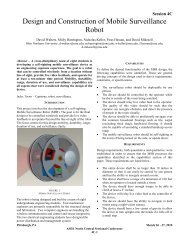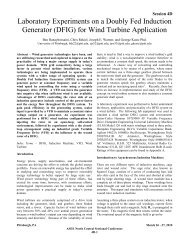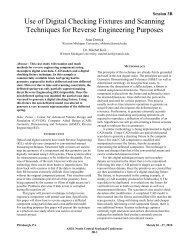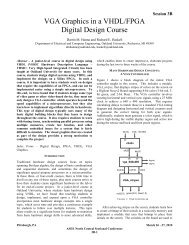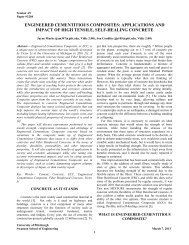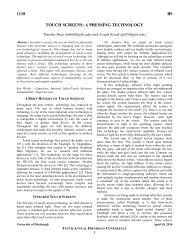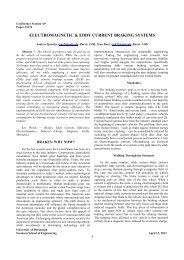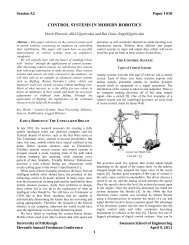THE ECOBOOST ENGINE: COMBINING VARIABLE VALVE TIMING ...
THE ECOBOOST ENGINE: COMBINING VARIABLE VALVE TIMING ...
THE ECOBOOST ENGINE: COMBINING VARIABLE VALVE TIMING ...
Create successful ePaper yourself
Turn your PDF publications into a flip-book with our unique Google optimized e-Paper software.
Neil Debski<br />
Seth Kahanov<br />
EcoBoost-equipped F-150s now account for more than 40<br />
percent of F-150 retail sales. [24]. However, the EcoBoost<br />
engine is not only limited to trucks. Standard four door<br />
sedans such as the Ford Focus, Taurus, and Explorer allow<br />
for the fuel saving technology to be available to consumers<br />
of all car preferences for just a small increase in cost. Even<br />
sports cars such as the iconic Ford Mustang will be getting a<br />
green makeover. Ford executives have confirmed the<br />
adoption of EcoBoost engines for the next generation<br />
Mustang in 2015 [25]. Ford has committed to making<br />
EcoBoost available to 90 percent of its nameplates by 2013,<br />
and adding in the Mustang will take that figure closer to 100<br />
percent [25]. Ecoboost owners who drive 15,000 miles per<br />
year will save a little less than $200 annually at the pump<br />
(with gas at $3.23 a gallon) [26]. The cost of an EcoBoost<br />
upgrade option, depending on the vehicle type, ranges from<br />
$900 to $1500. With an average car lasting around 150,000<br />
miles before resale or scrapping, the EcoBoost engine pays<br />
for itself. These statistics show that the EcoBoost is an<br />
ethical step in the right direction as a fuel saving, pollution<br />
reducing, money saving engine that is suitable in price to<br />
most new car buyers. For this reason, the Ford Motor<br />
Company should continue to improve their line of EcoBoost<br />
Engines. In regards to modern car owners, Ford Vice<br />
President of Powertrain Engineering Joe Bakaj explains,<br />
“Many customers would like the fuel efficiency of a modern<br />
diesel or a hybrid, but can’t stretch their budgets to cover the<br />
cost premium. That’s where the EcoBoost fits in. It will<br />
offer a highly fuel-efficient alternative at a lower cost,” [27].<br />
Not only has this engine made the driving experience user<br />
friendly, its initial benefits are sustainable to hold true no<br />
matter how the rest of the vehicle’s design has been<br />
modified .<br />
<strong>ECOBOOST</strong>: AN IRREFUTABLE<br />
OPTION<br />
Drivers have several choices regarding what type of<br />
engine and vehicle to use on a day to day basis. Considering<br />
how often a driver needs to have easy access to a<br />
manageable ride, this choice should be made regarding<br />
impacts that the car will make that will affect them the most.<br />
These effects that engine designs have are on the economy<br />
and environment that the driver is living in. These have<br />
always been concerns of mechanics while designing engines,<br />
but have never been dealt with in such a balanced and<br />
efficient way as the Ford EcoBoost engine. Previous<br />
attempts to better the fuel economy and environment have<br />
involved increasing the size of the engine and lowering the<br />
compression ratio [5]. This would better the environment,<br />
but decrease the performance of the engine overall. The later<br />
realization of why fuel is being wasted was explored in the<br />
MinDwell design, which made the injection site within the<br />
engine more controlled [9]. This decrease in fuel waste<br />
sparked the emphasis on direct fuel injection for all engine<br />
mechanics, and allowed Ford to design the entire EcoBoost<br />
engine around it.<br />
The direct injection involved in the EcoBoost engine uses<br />
spark ignited direct injection technology, which allows the<br />
engine to inject the fuel in the air in the cylinder and then<br />
ignite the mixture with a spark plug [11]. This enables the<br />
engine to use more of the fuel that is applied to it without<br />
having to release it into the atmosphere during the Otto<br />
cycle. The following crucial technology is the EcoBoost’s<br />
unique variable valve timing which reduces emissions by<br />
controlling the fuel flow to the engine even while the throttle<br />
is slightly open [13]. This is essential to benefitting the fuel<br />
economy of the engine, since the driver will not have to pay<br />
for as much gas, if the gas they initially put in their engine is<br />
being used completely to help the function of the engine.<br />
Another important aspect of the EcoBoost engine is its<br />
efficient turbocharging. The EcoBoost’s turbocharging helps<br />
give the engine the boost that it needs to continue through<br />
the Otto cycle, while cooling the system to both ease starting<br />
ignition and prevent harm or damage to the engine [28]. This<br />
cooling and charging allows the engine to perform at high<br />
quality for long periods of time without the need to stop for<br />
more fuel.<br />
Given all of the EcoBoost’s innovative technology, the<br />
choice to commit to the engine’s benefits comes from its<br />
economic and environmental benefits. The EcoBoost’s<br />
optimization of fuel allows the engine to achieve higher<br />
horsepower at lower rpm, which continues to decrease the<br />
constant need for fuel [3]. This high performance with low<br />
levels of fuel decreases the total amount of money the driver<br />
needs to spend on gasoline, making the cost benefit analysis<br />
favor the initial purchase of the engine. There are several<br />
other companies producing what they believe are highly<br />
efficient engines, but their comparison to the EcoBoost<br />
leaves them flawed. Despite other automotive companies<br />
being able to increase the performance efficiency of their<br />
engines, they are not able to better the fuel economy to the<br />
extent that the EcoBoost engine does [20]. The EcoBoost<br />
engine minimizes the space it occupies within the vehicle,<br />
which in turn gives opportunity for precise direct injection of<br />
fuel. This improvement wastes less fuel, solving both<br />
economic and environmental problems at once. Considering<br />
how long society has had these problems, it is odd to think<br />
of why this innovative technology was not released sooner.<br />
REFERENCES<br />
[1] (2012) “Fuel Efficiency Takes Baby Steps in the Auto<br />
Industry.” New York Times. (Newspaper).<br />
http://www.nytimes.com/2012/06/21/business/global/fuelefficiency-takes-baby-steps-in-the-autoindustry.html?pagewanted=all<br />
[2] (2012) “Ford Puts the Pedal to Its EcoBoost Engine-Tech<br />
Brand.” Forbes. (Online Periodical).<br />
7




